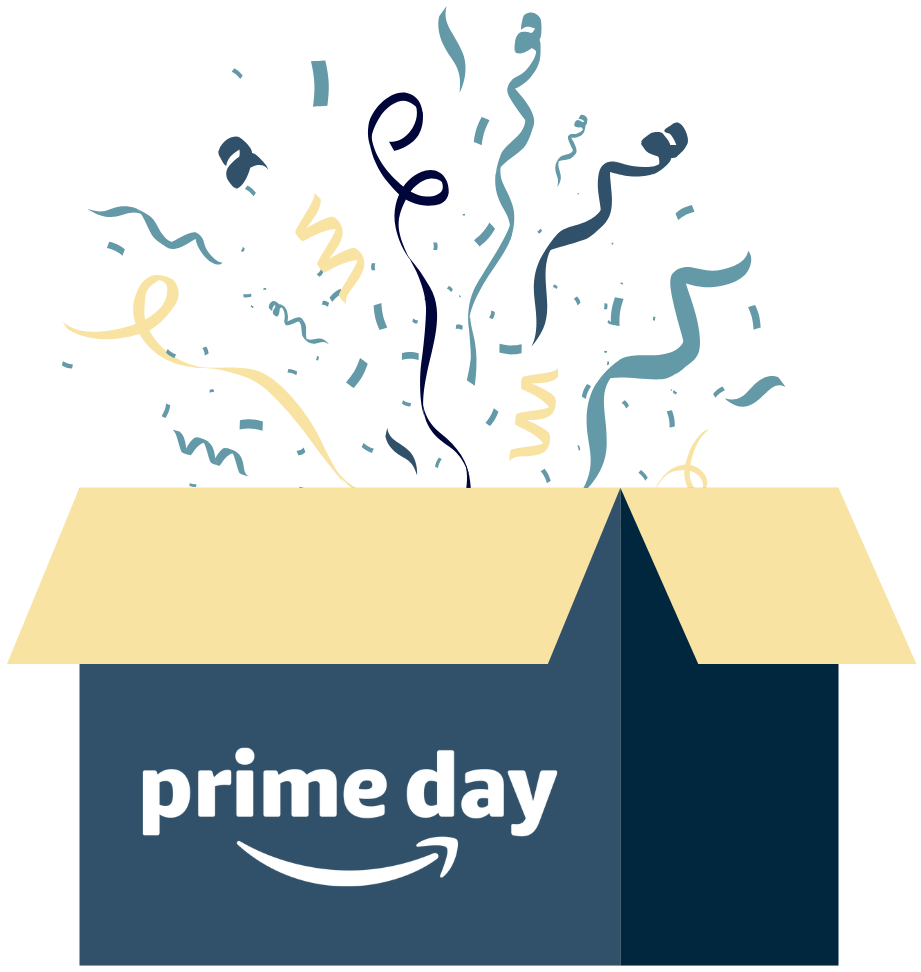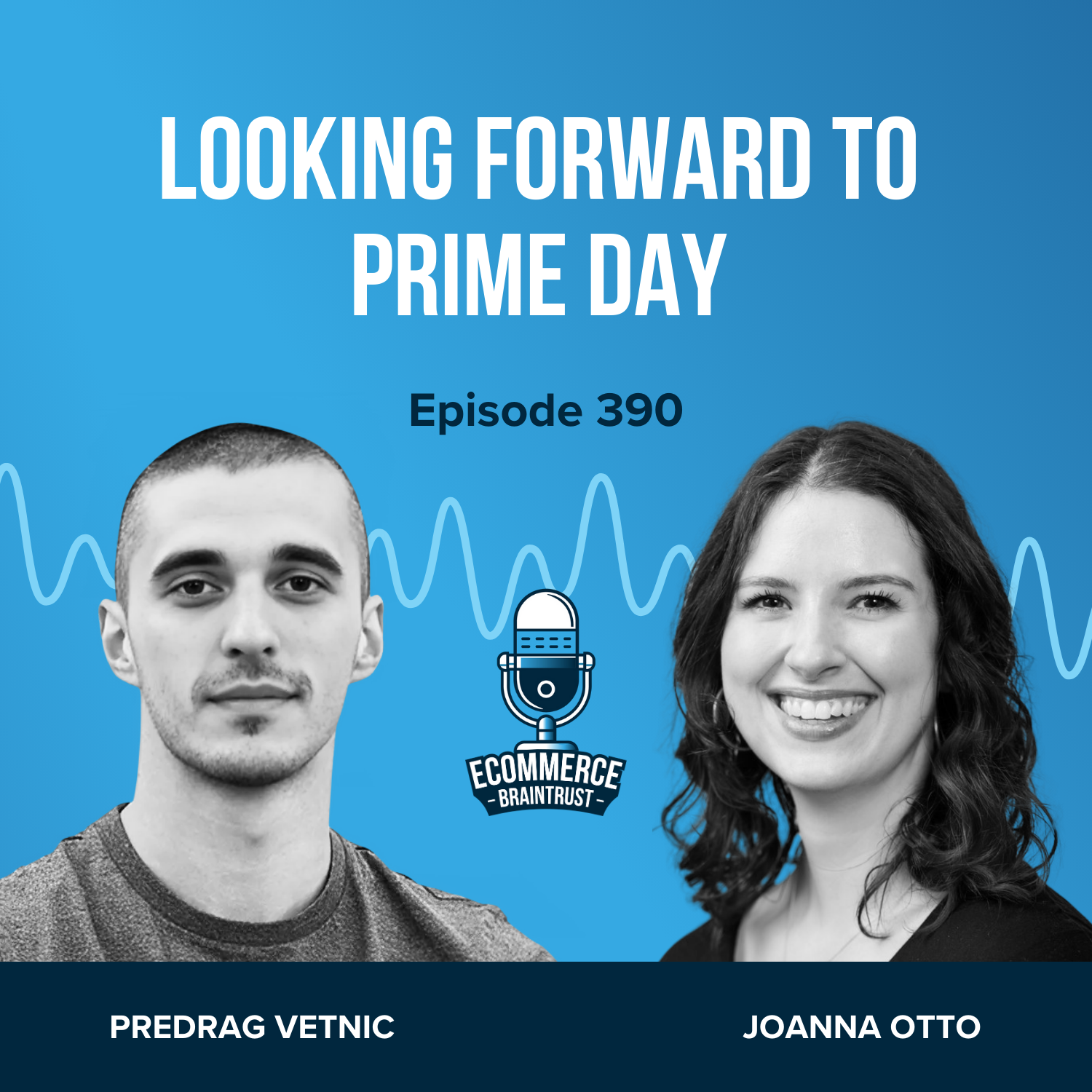🎧 On the go? Listen to this roundup in audio format.
There’s no such thing as a peaceful Prime Day. Once it begins, there’s not much you can do but ride the wave, so the countdown has officially begun.
Whether you're a veteran seller or stepping in for the first time, what you do to prepare now could define your entire Q3 and maybe your whole year.
So today, we’re kicking off a special two-part series designed to get you Prime Day-ready.
In Part 1, we're diving into the key operational, promotional, and organic strategies that separate the winners from the rest.
Backed by Acadia’s top strategists, this series will help you prep smart, execute confidently, and win big. Let’s get into it.
Critical Dates for Prime Day 2025
Prime Day may fall in mid-July, but waiting until then to start planning is like training for a marathon the night before.
By the time the official date is announced — typically just a few weeks before the event — the brands that win will already be in motion: launching campaigns, optimizing listings, locking in deals, and sending in inventory.
Here’s a breakdown of the key dates and what they mean for both vendors and sellers:

May 15 – AWD Inventory Deadline
If you’re using Amazon Warehousing & Distribution (AWD), inventory must be received by May 15 to guarantee Prime badge eligibility. This is Amazon’s “Prime-ready” program — miss this and you risk losing the Prime shipping promise, which heavily impacts conversion rates during the event.
💡 Without the Prime badge, your offer won’t compete. This is especially critical for Buy Box retention and deal visibility.
May 23 – Deal Submission Cutoff
This is the last day to submit Lightning Deals, Best Deals, and Prime Exclusive Discounts (PEDs) for Prime Day.
Submission window opened: March 18
Cutoff for scheduling: May 23
If you don’t check the “Prime Day Deal” box when submitting a PED, your product won’t get the Prime Day badge — even if the deal runs during the event.
💡 That badge can mean a 5.5x boost in sales compared to just 1.65x for unbadged coupons.
June 9 – FBA Inventory Deadline (Minimal Shipment Splits)
This is the date by which your FBA inventory must arrive to avoid split shipments. In other words, this is your best shot at sending inventory to a single location for faster check-in.
💡 Split shipments can cause delays and complicate fulfillment logistics. Get inventory in early for smoother operations and less risk.
June 18 – FBA Inventory Deadline (Amazon-Optimized Splits)
Final call for Amazon-optimized shipment plans. After this point, Amazon makes no promises about inventory being available for Prime Day.
💡 If your inventory isn’t checked in and ready by this date, it may not be included in Prime Day deals or featured in search and browse placements — even if you’ve submitted the deal on time.
⌛ Summary Timeline
| Date | Milestone | Key Impact |
|---|---|---|
| May 15 | AWD Inventory Deadline | Guarantees Prime badge eligibility |
| May 23 | Final Day to Submit Deals | Required for deal badging and inclusion |
| June 9 | FBA Arrival Cutoff (Minimal Shipment Splits) | Streamlined inventory routing |
| June 18 | FBA Arrival Cutoff (Amazon-Optimized Splits) | Final window to ensure inventory is Prime-ready |
Missing even one of these dates can jeopardize your Prime Day performance. Plan backward from each deadline, give your operations team a buffer, and lock in your inventory and promotions as early as possible.
Building Momentum Before Prime Day
Amazon doesn’t hand out extensions or second chances. Early preparation isn’t just about hitting deadlines — it’s about gaining algorithmic momentum.
Amazon’s ranking system rewards products that show sales velocity, review growth, and strong click-through and conversion rates in the weeks before Prime Day.
Here’s what separates the brands that crush Prime Day from the ones that just show up:
1. Get Reviews Rolling
Nothing builds trust or conversions like social proof. Amazon’s algorithm takes both review quantity and recency into account.
Tactics to deploy:
- Vine Program (for new products): Fast-track early reviews with Amazon-vetted contributors.
- ProductWind campaigns: Pair influencer content with targeted promotions to drive fast engagement and review generation.
- Post-purchase emails: Ensure you're using tools (like Amazon’s Request a Review button or third-party services within TOS) to politely ask for feedback.
Reviews seeded in April and May will carry weight just in time for peak Prime Day visibility.
2. Drive Sales Velocity with Smart Promotions
Sales volume is a core ranking signal. Brands that drive intentional, pre-Prime Day purchases are rewarded with better positioning and stronger relevance scores when deals go live.
Ideas to test:
- Run small promotions or coupons in May to trigger increased purchases.
- Target high-intent audiences via DSP or Sponsored Display retargeting.
- Bundle products or offer time-limited discounts to accelerate purchases.
- Use UGC (User Generated Content) to drive external traffic via TikTok, Instagram, or YouTube.
Velocity spikes before Prime Day improve your Best Seller Rank (BSR), which directly influences organic visibility on search and category pages.
3. Refresh Your Listings with Strategic SEO
Prime Day shoppers don’t just click — they search. And if you’re not showing up on page one, you’re invisible.
Now is the time to:
- Re-crawl your listing content: Update titles, bullet points, and back-end keywords to reflect high-volume, high-conversion search terms.
- Use competitive keyword scraping: Identify gaps in your listings versus your category leaders.
- Update A+ content and imagery: Especially infographics, which are more frequently viewed than bullet points.
- Include customer intent language: Speak directly to what your audience wants ("best for summer travel", "durable for everyday use", etc.).
Organic visibility isn’t built overnight. The earlier you start refining, the more time Amazon’s algorithm has to reward you.
4. Invest in User-Generated and Influencer Content
Influencer and UGC content is one of the highest-performing forms of pre-event momentum-building. Why? It’s authentic, trustworthy, and it converts, especially when it’s paired with timely promos or links that drive directly to your Amazon listings.
What works:
- TikTok or Instagram Reels showing the product in action.
- Amazon Attribution links to track off-platform traffic.
- Short-form testimonial-style ads that build credibility fast.
UGC also helps with long-term brand building and can be repurposed in Amazon Posts, A+, Content, and brand stores.
5. Test and Learn Early — So You Can Scale Smart Later
Prime Day ad costs spike dramatically. If you wait until July to test copy, keywords, or targeting, you’ll spend a lot more for less learning.
Instead, use May to:
- Test your best-performing search terms.
- Run small-budget campaign tests across Sponsored Products, Brands, and Display.
- Refine your audience segments and placements.
- Set up automated rules to scale what’s working in real time once Prime Day starts.
Adapting to a Four-Day Prime Day
What was once a 48-hour event is now a four-day e-commerce marathon, doubling both the opportunity and the operational complexity for brands.
If you’re approaching this like a two-day sprint, you’re going to fall behind.
Here’s how to recalibrate your strategy for a full 96 hours of Prime Day.
1. Expect Sustained Traffic — Not One Big Spike
In previous years, Day 1 of Prime Day would often outperform Day 2. But that pattern is breaking. Day 2 sales outpaced Day 1 in 2024, and the expectation for 2025 is a steady stream of traffic across all four days.
Amazon shoppers are adapting. They’re:
- Browsing early.
- Comparing deals.
- Waiting for last-minute drops.
- Shopping throughout the entire event window, not just at the start.
Your campaigns, inventory, and monitoring systems must be built to sustain performance, not peak and drop.
2. Prime Badge = Prime Advantage
Badge visibility is more important than ever in a longer event. Amazon’s promotional badging (on Prime Exclusive Discounts, Lightning Deals, and Best Deals) has been shown to drive 5.5x sales uplift versus just 1.65x for unbadged promotions.
Over a four-day window, this badge becomes a powerful competitive weapon — not just for visibility, but for Buy Box retention, ad conversion, and organic ranking.
Make sure your Best Deal & Lightning Deals submissions are:
- Submitted by May 23.
- Properly tagged as Prime Day-specific (or you won’t get the badge).
- Competitive enough to meet Amazon’s discount threshold.
- Prime Exclusive Discounts are able to submit within days of the event.
3. Spread Your Budget Strategically
Doubling the length of Prime Day doesn’t mean you need to double your media budget — but it does mean you need to allocate it more carefully.
- Front-load slightly for Day 1 to catch early shoppers.
- Maintain strong support through Days 2 and 3 when competitors often fatigue or drop off.
- Reserve a flexible budget for Day 4 in case of last-minute deal performance or surging ASINs.
- Monitor campaign pacing and CPCs daily, and be ready to reallocate dynamically.
Four days means more signals, more data, and more chances to adjust if you're actively monitoring performance in real time.
4. Extend Your Deal Strategy to Match the Event Window
If you’ve previously run 2-day Lightning or Best Deals, it’s time to think bigger. Amazon’s event calendar and consumer behavior suggest that a longer runway drives higher ROI, especially if you stagger deal coverage across different ASINs.
- Run different ASINs each day to keep your catalog fresh and give shoppers new reasons to buy.
- Pair PEDs (Prime Exclusive Discounts) with evergreen coupons to create a tiered offer structure.
- Use dynamic targeting to conquer competitors who don’t maintain deal visibility across all four days.
5. Prep Your Team for an Extended Event
A four-day Prime Day requires more monitoring, faster response times, and greater operational stamina. This isn’t a “set it and forget it” play.
Be prepared for:
- Buy Box disruptions
- Listing suppressions
- Price changes
- Customer messages
- ASIN performance shifts
Prime Day is never peaceful. Four days means four times the chances for things to break — and four times the upside if you’re ready to act.
Navigating Changes in Merchandising Fees
Amazon has made some important — and potentially costly — changes to its merchandising fee structure in 2025, and if you’re not reading the fine print, you might find your margins disappearing faster than your Lightning Deals sell out.
Understanding how these changes affect Prime Exclusive Discounts (PEDs), Lightning Deals, Best Deals, and coupons is critical. You can’t afford to blindly submit promotions this year — the math matters more than ever.

Prime Exclusive Discount (PED) Fees Have Doubled
- Old fee: $50 per PED
- New fee: $100 per PED
Amazon doubled the PED fee to reflect the expansion of Prime Day from 2 to 4 days. More exposure, more opportunity — but also more cost.
This fee applies per ASIN per deal, so if you're submitting PEDs across a wide portfolio, the total cost can climb quickly.
Best and Lightning Deal Fees Remain High
Fee: $1,500 per deal
This hasn’t changed, but it’s still a significant fixed cost, especially for small to mid-sized brands. You must weigh the potential visibility and uplift against the guaranteed upfront spend.
New Coupon Fee Structure (Effective June 2, 2025)
Amazon has overhauled how it charges for coupons, and the implications are big.
New structure:
- $5 per coupon (flat fee)
- Plus 2.5% of revenue generated by coupon redemptions
Example: If your coupon generates $10,000 in sales, you’ll owe $250 in percentage fees, plus the $5 flat fee, regardless of your margins.
This change introduces a performance-based fee on top of the existing flat cost, and it may eat into your profits, especially on lower-margin products.
The Deal Badge: Why It’s Worth the Investment
Not all deals are created equal. What really matters is whether your offer receives the Prime Day Deal badge — and that depends on two things: submitting your deals by the May 23 deadline and ensuring your deals are correctly tagged for Prime Day
- Badged PEDs drive up to 5.5x sales uplift
- Unbadged coupons average just a 1.65x lift
In short: don’t pay the fee if you’re not getting the badge — the return simply won’t justify the cost.
So… Which Promotion Type Should You Use?
This year, you need to run the numbers before committing to any deal. We suggest creating a break-even calculator that factors in:
- Promotion fee (PED, Best Deal, Coupon)
- Discount offered
- Estimated uplift (based on past Prime Day performance)
- Product margin
- ACOS (if advertising is layered in)
In some cases, offering a slightly deeper discount via PED may be more cost-effective than running a coupon that takes 2.5% of all resulting sales.
Smart Brands Are Running the Math Now
With Prime Day spanning four days, your promotional choices must be data-driven and margin-aware. And with Amazon increasing its slice of the pie through new fee structures, there's less room for guesswork.
If you haven’t already:
- Audit your margin by ASIN
- Model different promo types side-by-side
- Use historical Prime Day performance to predict uplift
- Decide whether a PED, Lightning Deal, or targeted coupon makes the most sense, or if skipping a promotion altogether is the smarter move
The Rise of AI-Driven Shopping
In 2025, Amazon’s shopper experience is also being reshaped by AI, particularly through its native assistant, Rufus. Prime Day could be the moment when AI-assisted shopping hits the mainstream.
Rufus is Amazon’s generative AI tool designed to act as a smart shopping guide. By October 2024, Rufus was responsible for 40% of all Amazon searches. That number is expected to rise to 50 %+ by the end of 2025.
Brands are no longer competing solely for keyword rankings — they’re competing for placement in AI-generated recommendation sets, which are built around customer intent, product relevance, and content quality.
Traditional product discovery on Amazon has been driven by:
- Search terms
- Filters (price, rating, category)
- Ad placements (sponsored products, brands)
Now, AI is changing the flow:
1) Shoppers ask open-ended questions.
2) Rufus interprets intent and recommends products.
3) Recommendations are ranked not just by CTR or BSR, but by how well your product “answers” the question.

Example: Instead of searching for “running shoes,” a shopper might ask: “What’s the best shoe for marathon training in hot weather?”
If your listing doesn’t contain intent-driven phrases and relevant content (think: “breathable mesh,” “long-distance support,” “hot weather running”), you won’t make the cut, no matter how many reviews you have.
To position your products for AI-powered placement, brands must start thinking beyond keywords and focus on semantic relevance and content alignment with customer intent.
Here’s what to do:
1. Rethink Product Copy With Intent in Mind
- Move beyond features → focus on benefits tied to real-life use cases.
- Use natural language that aligns with customer questions (“best for…” “ideal if you…”).
- Optimize for longer-tail queries that reflect how people speak, not just how they search.
2. Upgrade Your Visuals for AI Readability
- Include overlay text on images to emphasize core benefits (Rufus can "read" these).
- Use infographics that clearly call out: use cases, comparisons, key differentiators.
- Ensure image alt text and metadata are complete and relevant.
3. Incorporate UGC and Reviews That Reflect Real Scenarios
- Rufus pulls from customer reviews when matching products to queries.
- Encourage reviews that describe specific use cases
- Leverage UGC where customers explain the product in context (videos, quotes, testimonials).
4. Update A+ Content and Storefront Language
- Include question-style headers and benefit-driven sections.
- Create modules that answer likely customer questions or compare solutions side-by-side.
5. Monitor Performance and Placement in AI-Powered Results
- Use Amazon Attribution and internal tools to see how customers are engaging with listings from new entry points.
- Track any changes in traffic patterns or conversion behavior as Rufus adoption grows.
Preparing Your Operations for Prime Day Chaos
If there’s one universal truth about Prime Day, it’s this: something will break.
Let’s walk through exactly what needs to happen to keep your brand protected and performance-optimized.
Step 1: Confirm All Promotions Are Live, Badged, and Error-Free
Before Prime Day even begins, triple-check:
- Your deals are approved and tagged as Prime Day-specific (otherwise, you won’t receive the deal badge).
- Discounts meet Amazon’s criteria (especially PEDs, which require a minimum discount based on the lowest price in the last 30 days).
- All ASINs are Prime-eligible, in stock, and Buy Box-winning.
Even a small tagging or eligibility error can lead to your promotion running without visibility, or not running at all.
Step 2: Expect Listing Suppressions and Policy Flags
Last year alone, Acadia’s team dealt with:
- Trademark infringement reports (some filed during Prime Day, resolved weeks later).
- Product detail page take-downs with no warning.
- Health flag alerts that derailed ad campaigns.
- Buy Box losses due to price fluctuations or unauthorized resellers.
You can’t control everything, but you can:
- Set up a monitoring routine for account health notifications.
- Have a designated point person ready to respond to Amazon Seller/Vendor Support.
- Pre-draft appeal messages for your most vulnerable ASINs so you can respond quickly.
Step 3: Set Up Competitor and Category Monitoring
Smart brands don’t just monitor themselves — they watch the competition like hawks.
The Acadia team recommends using tools to:
- Track 20–30 top competitors in your category.
- Monitor their deal activity, badge status, pricing, and Buy Box ownership.
- Identify gaps or missed opportunities in their strategy (e.g. if they aren’t running deals or lose the Buy Box during the event).
This lets you conquer high-value branded terms in real time and redirect ad dollars to steal traffic from weaker competitors.
Step 4: Enable Real-Time Alerts for Price and Buy Box Changes
You need automated systems in place to notify your team of:
- Price drops (intentional or unauthorized)
- Buy Box losses
- Deal removals or unbadging
- Listing suppressions
Acadia uses a combination of internal tools and third-party software to trigger instant alerts, allowing teams to jump into action rather than discovering an issue after losing hours (or days) of traffic.
Step 5: Build Contingency Plans for High-Risk Scenarios
You won’t always get fast help from Amazon, so your best bet is to plan around that reality.
What to prepare:
- Backup ASINs to shift promotions to in case a key listing goes down.
- Flexible campaign budgets that can be reallocated by ASIN or ad type.
- A documented response plan for each of the following:
- Listing takedowns
- Unauthorized seller interference
- PED rejection or suppression
- Ad group performance collapse
You must be ready to “switch promotional times or pivot spend immediately” if things go sideways — because they will.
Thriving Amid Economic Uncertainty
While Prime Day promises massive traffic and sales potential, brands in 2025 are preparing for it against a backdrop of economic turbulence: fluctuating consumer demand, ongoing inflationary pressures, supply chain constraints, and the looming threat of tariffs that could dramatically alter cost structures.
This year feels like a “will-they-won’t-they” drama with tariffs, and that volatility is putting strain on how brands approach pricing, promotions, and profitability.
To navigate Prime Day successfully this year, brands must lead with strategic precision, financial discipline, and operational flexibility.
Tariffs, Pricing, and Promotional Pressure
If tariffs do go into effect — or even if brands just anticipate them — the natural reaction is to raise prices to protect margins. This is where things get tricky on Amazon.
Amazon is never a fan of price increases, and they will push back with Buy Box losses, especially during promotional periods.
Here’s why:
- Amazon calculates promotional discounts (for PEDs, Lightning Deals, etc.) based on the lowest price in the last 30 days.
- If a brand increases its price in June to account for rising costs, Amazon may still anchor the discount to the lower pre-tariff price, effectively forcing a deeper discount than expected.
- If you raise prices too aggressively, you risk losing the Buy Box, even on your own listings, killing conversion rates and deal visibility.
The Tradeoff Between Margin Protection and Deal Participation
Given the increasing costs — from Amazon fees to coupons to inventory holding — some brands are asking: “Is participating in Prime Day even worth it this year?”
The answer? It depends on your strategic goals.
Ask yourself:
- Am I optimizing for short-term revenue, long-term ranking, or customer acquisition?
- Can I afford to sacrifice margin in the short term to gain BSR, reviews, and visibility that pays off across Q3 and Q4?
- If my margins are razor-thin, could a scaled-back promotion or tighter targeting (via Sponsored Display or DSP) yield more controlled performance?
Be strategic about when and how you raise prices. If tariffs hit, they will happen — just plan ahead.
Operate With a Clear-Headed Mindset
Amid economic chaos, your biggest competitive advantage is clarity and agility.
Here’s how the top-performing brands are thinking:
- Plan proactively — don’t leave pricing, inventory, or promotional strategy to last-minute guesswork.
- Use data, not emotion, to drive decisions — especially when promotions feel “expensive.”
- Don’t assume success is guaranteed — build risk buffers, contingency plans, and realistic performance expectations.
Final Thoughts
The only constant with Amazon is change.
Prime Day 2025 isn’t just longer — it’s smarter, faster, and more competitive than ever.
From tightening your operations and building pre-event momentum, to navigating changing fee structures and adapting to AI-driven discovery, success this year will go to the brands that prepare with clarity, agility, and intent.
So start early, stay sharp, and lead with data.
---
Let’s make 2025 your biggest Prime Day yet — stay tuned for part 2 and get ready with us!
Give It a Listen
You can tune in for the full discussion with Joanna Otto and Predrag Vetnic on the Ecommerce Braintrust hosted by Julie Spear and Jordan Ripley.
This show gives you access to the world's best brains when it comes to building momentum online for established consumer brands. Join in and listen to discussions with expert guests about e-commerce strategies, trends, and innovations.

